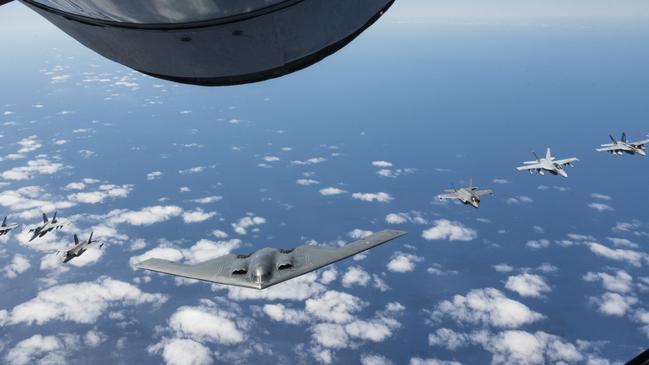US, Australian militaries join forces to retaliate China’s Pacific rise
Australia’s reaction time to a threat could be cut from 30 minutes to less than four under a new military alliance with the US. SEE HOW
Exclusive: Australia will join the “kill chain” of United States’ air and missile defence capabilities in a move that could cut our militaries’ reaction times from 30 minutes to less than four.
An interoperable American-Australian force in the Pacific has long been a dream for commanders where ships, planes and radars of both operate as one for a real time joint interception.
Now a series of “sensor to shooter” integration trials using surveillance and fighters from both countries have proved successful, paving the way for an unprecedented future forces alignment.
The shift to integrate warfare systems will significantly advance Australia’s strategic strike power in the region and particularly the Australian Defence Force’s ability to respond to a long-range threat.
It is also likely to see more US ships, troops and aircraft including the B-21 stealth in Australia which could act as a logistics base.

US Defense Secretary Lloyd Austin has reportedly expressed enthusiasm over the urgency of the Albanese government to further the AUKUS pact beyond just shared nuclear-powered submarine tech to broader war-fighting integration.
Defence Minister Richard Marles was coy on the detail but said as China sought to “reshape” the world, the alliance and forces’ interoperability was of critical importance.
“What that looks like is doing more exercises at a higher level, meaning more complex exercises, the military jargon would be ‘high end war fighting’, where greater interoperability is practised,” Mr Marles told News Corp Australia.
“I think we seek to build interoperability, I have used the word interchangeability as well as I guess an expression of the highest level of interoperability, we do want to see us develop that with the United States forces. There is considerable scope for greater complexity of exercises.”
Mr Marles said disputes were better mediated and resolved through the rule of law rather than “might and power”, particularly in the South China Sea and Australia’s trade sea routes, but Russia’s invasion and war with Ukraine was a warning to all.

“Given the global rules based order is under more stress or as much stress as it has been since any point since the end of Second World War our interest lies in maintaining an American presence in the East Asian time zone. I mean it very clearly does so I think it is very much in our interest for us to be doing more with America and us making sure that we keep America engaged in this part of the world.”
The so-called “kill chain” term refers to the process of identifying a target threat through surveillance and reconnaissance, choosing the best option to confront it and deploying a strike.
Trials have been conducted by both forces during Talisman Sabre exercise last year off the coast of Brisbane, the “Black Flag” exercise in Nevada in the US two months ago where RAAF strike fighters were used in the kill chain trial and the ADF as official observer to the American Scarlet Dragon program where AI decision making is being trialled.
Trials showed automated bilateral data transfer removed human error in transposing intelligence and cut response times from 25-30 minutes to up to four minutes.
More Coverage
Originally published as US, Australian militaries join forces to retaliate China’s Pacific rise




